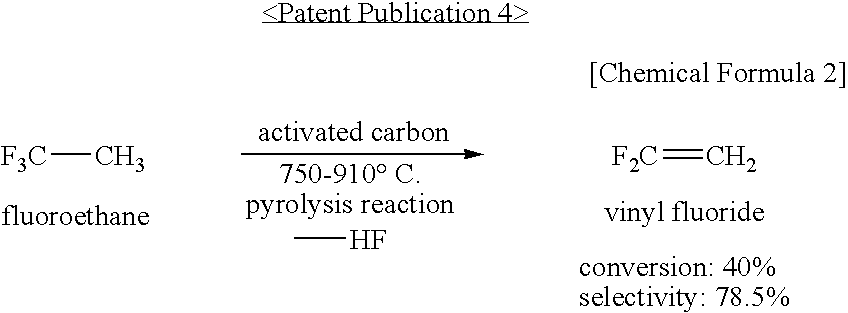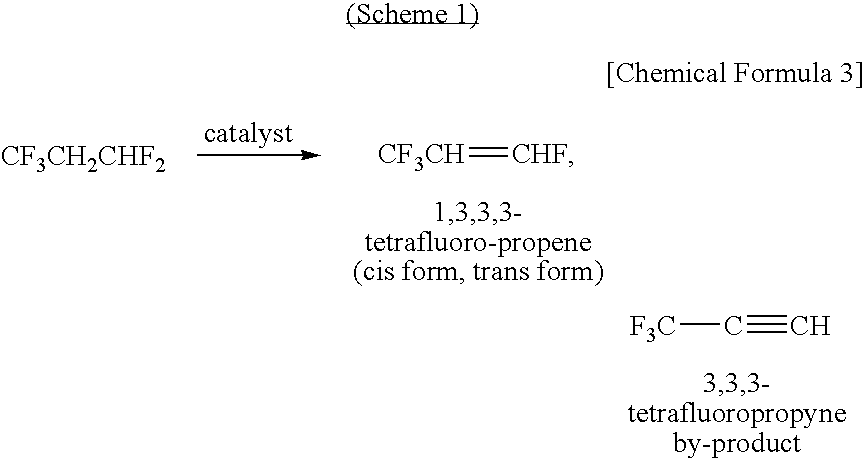Method for Producing 1,3,3,3-Tetrafluoropropene
- Summary
- Abstract
- Description
- Claims
- Application Information
AI Technical Summary
Benefits of technology
Problems solved by technology
Method used
Image
Examples
preparation example 1
[0041]4.5g of a special grade reagent ZrOCl2-8H2O was dissolved in ethanol. In this solution, 50 mL of spherical alumina having a diameter of 5 mm was immersed, followed by standing still for a whole day and night. Then, the solvent was distilled off, followed by drying at 150° C. under reduced pressure. The obtained zirconium-carried alumina was placed into a cylindrical reaction tube that was equipped with an electric furnace, had a diameter of 2 cm and a length of 40 cm, and was made of SUS316. The temperature was increased to 200° C., while nitrogen gas was allowed to flow. At the time when no water outflow was found, nitrogen gas was accompanied with hydrogen fluoride, and its concentration was gradually increased. When hot spot due to fluorination of the placed zirconium compound-carried alumina reached an outlet end of the reaction tube, the reactor temperature was increased to 450° C. That condition was maintained for 1 hour to prepare the catalyst.
preparation example 2
[0042]In a solution prepared by dissolving 3.3 g of a special grade reagent ZrOCl2-8H2O in ethanol, 50 mL of a granular activated carbon (Takeda Pharmaceutical Company Limited, GRANULAR SHIRO SAGI GX) having a diameter of 4-6 mm was immersed, followed by standing still for a whole day and night. Then, the solvent was distilled off, followed by drying at 150° C. under reduced pressure. The obtained zirconium compound-carried, activated carbon was placed into a cylindrical reaction tube that was equipped with an electric furnace, had a diameter of 2 cm and a length of 40 cm, and was made of SUS316. The temperature was increased to 200° C., while nitrogen gas was allowed to flow. At the time when no water outflow was found, nitrogen gas was accompanied with hydrogen fluoride, and its concentration was gradually increased. The reactor temperature was increased to 450° C., and that condition was maintained for 1 hour to prepare the catalyst.
preparation example 3
[0043]Catalysts were prepared under the same conditions as those of Preparation Example 2, except in that special grade reagents MoCl5, TiCl4, IrCl4 and SnCl4 were used, and they were dissolved in ethanol or water to make solutions.
PUM
 Login to View More
Login to View More Abstract
Description
Claims
Application Information
 Login to View More
Login to View More - Generate Ideas
- Intellectual Property
- Life Sciences
- Materials
- Tech Scout
- Unparalleled Data Quality
- Higher Quality Content
- 60% Fewer Hallucinations
Browse by: Latest US Patents, China's latest patents, Technical Efficacy Thesaurus, Application Domain, Technology Topic, Popular Technical Reports.
© 2025 PatSnap. All rights reserved.Legal|Privacy policy|Modern Slavery Act Transparency Statement|Sitemap|About US| Contact US: help@patsnap.com



